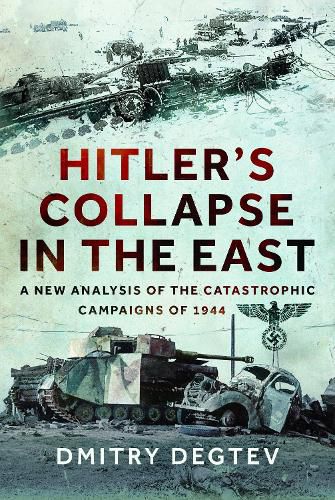Readings Newsletter
Become a Readings Member to make your shopping experience even easier.
Sign in or sign up for free!
You’re not far away from qualifying for FREE standard shipping within Australia
You’ve qualified for FREE standard shipping within Australia
The cart is loading…






When 1944 began, the Third Reich's position on the Eastern Front still seemed promising. Despite a series of major defeats at Kursk, Smolensk and on the Dnieper, the Germans still held vast swathes of Russian territory. Hitler declared that the conquered space would allow him to keep the Red Army away from the borders of Germany for a long time. However, such optimism was soon to be swept away. In January, the Soviets launched a powerful offensive in the northern sector, and then they repeatedly attacked the Germans in Ukraine, Crimea, Belarus, and the Baltic States. Then, on 22 June 1944, Stalin unleashed Operation Bagration, a massive offensive from which the German forces would never recover. Hitler's answer was to prohibit his generals from any retreat. This made operations easier for the Russians and led to the German divisions being encircled and trapped in pockets, most of which had to be supplied by air. Endless crisis situations forced the Wehrmacht to transfer its divisions from one sector of the front to another. Then the weakened sections of the defence collapsed, provoking more and more catastrophic defeats. The disaster that the German army experienced was on a scale never seen before in warfare. More than 70 percent of the divisions engaged were defeated, destroyed or captured. In nine months, the front had stretched from 500 miles to over 1,000 miles. But all these victories came at a price. The Red Army experienced several severe crises of its own, sustaining heavy losses. The Soviet command also committed strategic blunders. It overestimated its forces and reduced its effectiveness by dispersing its resources too widely. It also suffered from the constant interference of Stalin which often meant the real objectives of the campaign were lost and the Red Army was drawn into senseless costly battles. These events, and the participation of Soviet troops in them, are analyzed in detail in this truly ground-breaking book. AUTHOR: The author of some forty-five books, Dmitry Degtev is one of the leading Russian researchers of the history of the Second World War, having studied the air battles of the conflict and the history of the Luftwaffe and the Red Army Air Force for more than twenty years. Having worked as a journalist for many years, he has also studied the history of urban passenger transport, the history of crime and various aspects of people's lives in the Soviet Union. 16 b/w illustrations
$9.00 standard shipping within Australia
FREE standard shipping within Australia for orders over $100.00
Express & International shipping calculated at checkout
When 1944 began, the Third Reich's position on the Eastern Front still seemed promising. Despite a series of major defeats at Kursk, Smolensk and on the Dnieper, the Germans still held vast swathes of Russian territory. Hitler declared that the conquered space would allow him to keep the Red Army away from the borders of Germany for a long time. However, such optimism was soon to be swept away. In January, the Soviets launched a powerful offensive in the northern sector, and then they repeatedly attacked the Germans in Ukraine, Crimea, Belarus, and the Baltic States. Then, on 22 June 1944, Stalin unleashed Operation Bagration, a massive offensive from which the German forces would never recover. Hitler's answer was to prohibit his generals from any retreat. This made operations easier for the Russians and led to the German divisions being encircled and trapped in pockets, most of which had to be supplied by air. Endless crisis situations forced the Wehrmacht to transfer its divisions from one sector of the front to another. Then the weakened sections of the defence collapsed, provoking more and more catastrophic defeats. The disaster that the German army experienced was on a scale never seen before in warfare. More than 70 percent of the divisions engaged were defeated, destroyed or captured. In nine months, the front had stretched from 500 miles to over 1,000 miles. But all these victories came at a price. The Red Army experienced several severe crises of its own, sustaining heavy losses. The Soviet command also committed strategic blunders. It overestimated its forces and reduced its effectiveness by dispersing its resources too widely. It also suffered from the constant interference of Stalin which often meant the real objectives of the campaign were lost and the Red Army was drawn into senseless costly battles. These events, and the participation of Soviet troops in them, are analyzed in detail in this truly ground-breaking book. AUTHOR: The author of some forty-five books, Dmitry Degtev is one of the leading Russian researchers of the history of the Second World War, having studied the air battles of the conflict and the history of the Luftwaffe and the Red Army Air Force for more than twenty years. Having worked as a journalist for many years, he has also studied the history of urban passenger transport, the history of crime and various aspects of people's lives in the Soviet Union. 16 b/w illustrations